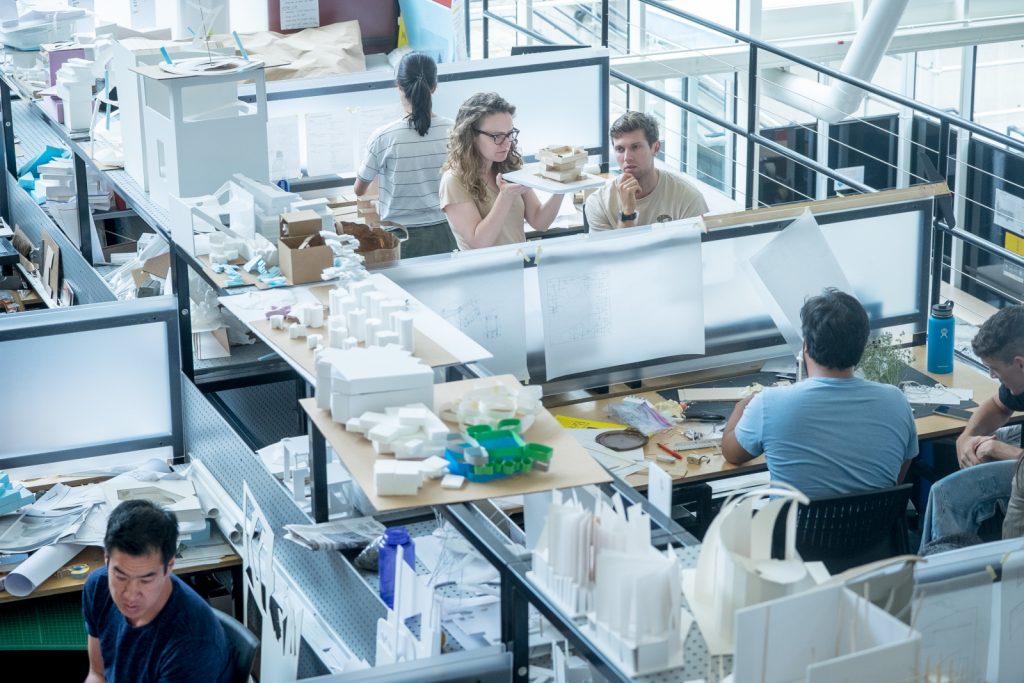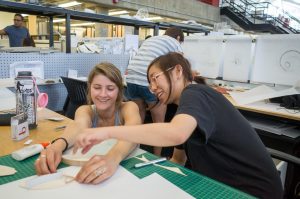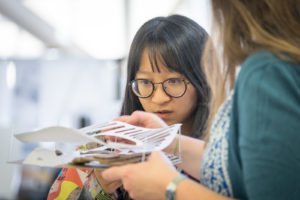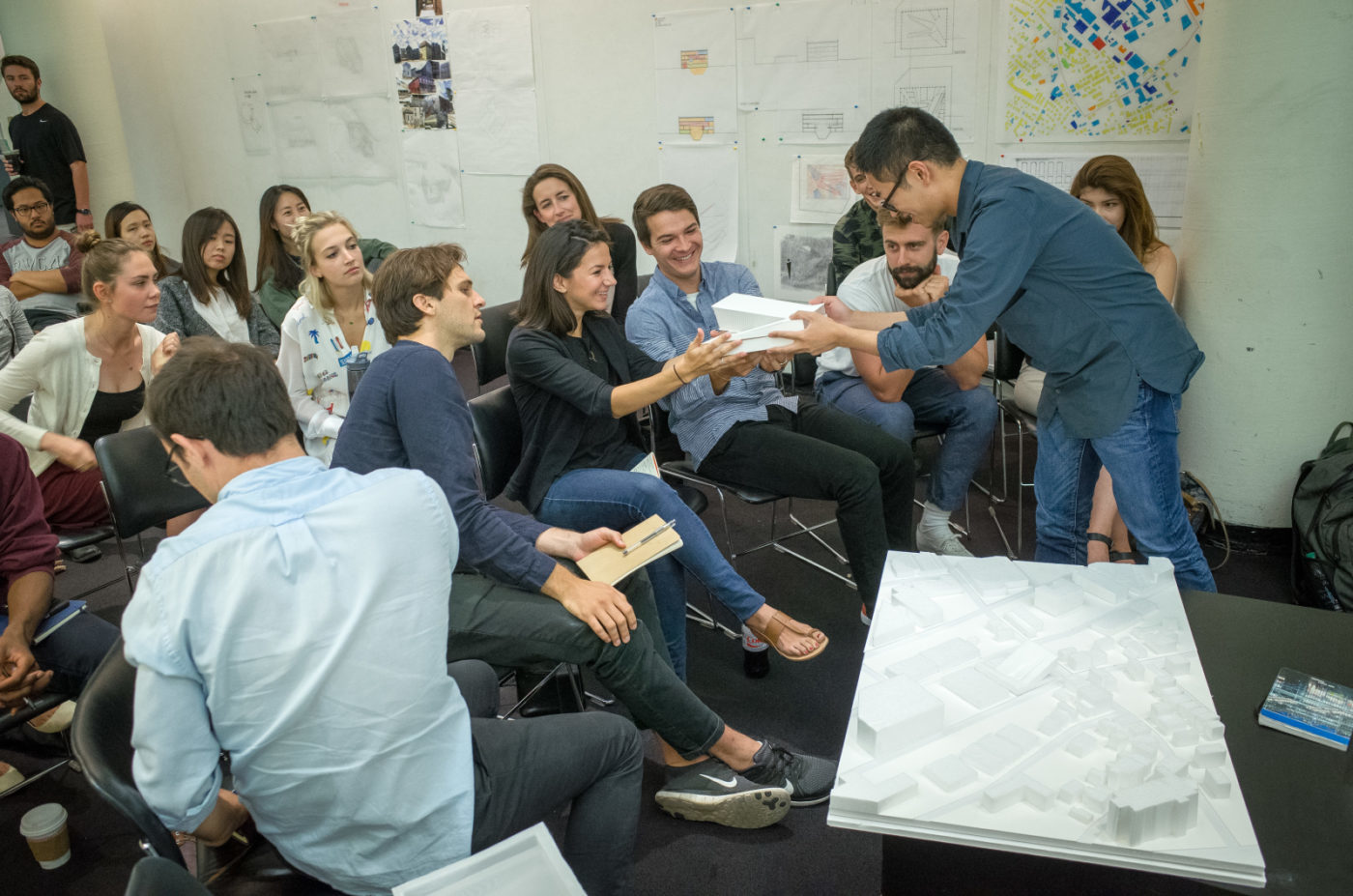By Henry Hays
At the final review for the summer 2016 Career Discovery program, instructor Iman Fayyad (MArch ’16) surveys her students’ final projects one last time before visiting experts begin their critiques. Critics will discuss the concepts, the larger social assumptions and implications, the technological possibilities, and the philosophical foundations behind the designs. “A lot of the Career Discovery program is learning about design culture,” Fayyad says. “You know everyone here is a good student, but it is very different working in the studio than it is sitting at your desk writing a paper. When four critics give you four different opinions during a review, how do you know which one to take?”
Design culture traditionally evokes “desk crits,” pin-ups, and group discussions of the physical models and elaborate representations that students employ to illustrate designs that have not yet been actualized—that exist, for the moment, only in the architectural imagination. During their six weeks at the GSD, as Career Discovery students learn the technical rudiments behind the design disciplines, they also gain insight into the less-tangible elements of design culture.
 Career Discovery instructors encourage evolution of a design idea, and the supporting discourse involved in its verbal and visual representation, rather than perfection of a final product. In her second year as the program’s architecture faculty lead, design critic in architecture Megan Panzano (MArch ’10) has initiated a structural change to address such representational considerations.
Career Discovery instructors encourage evolution of a design idea, and the supporting discourse involved in its verbal and visual representation, rather than perfection of a final product. In her second year as the program’s architecture faculty lead, design critic in architecture Megan Panzano (MArch ’10) has initiated a structural change to address such representational considerations.
“The means by which we communicate our design intentions is now a central motivator more than it has been in the past,” Panzano says. Accordingly, instructors reflect this in their teaching by pushing the conceptual process, speculation, and critical thinking over simple problem solving.
Career Discovery students approach design from a diversity of interests and experiences. Many plan to pursue a graduate degree in a design field, and use the program as a means to create a portfolio for the application. Others enter Career Discovery hoping to develop a grasp of design thinking and apply it in other fields, including business, health sciences, and media technology. And some come in as mid- or late-career professionals hoping to expose themselves to design culture for career flexibility, or even just for pure fun.
“Having so many people with so many different interests in the same studio helps a lot because everybody brings their own take on the issues at hand,” says Fayyad. “I’ll tell [students] to go walk around and see what other studios are doing so that we’re not just constrained to our pod. A collaborative spirit seems to be a natural extension of the design process. ”

After getting to know one another, students learn to give each other critiques and advice. “The dynamic is there to learn from each other,” says instructor Kelley Hess (MArch ’15). “I think that [students] learn something different from each other than what they learn from me.”
It can difficult for a student to separate the design process from the expectation that an exquisite artifact will emerge at the end. But when the creation of a beautiful product is prioritized over the rigor of process, instructors note, there is a risk of misaligning one’s understanding of the representational project. “Some come in just to make a portfolio and they care a lot more about having beautiful drawings, beautiful models, everything to be complete, and keeping things simple,” Fayyad observes. “So a lot of the time, I’m pushing. I have an expectation for conceptual material to be pushed to a certain level.”
To better understand the importance of conceptualization, Career Discovery studios regularly take tours of buildings and sites in Boston and Cambridge. Instructors point out elements of the building that might otherwise go unnoticed—the way the space around you makes you move at a certain pace and direction, and act in a certain way, for example. Students are encouraged to offer interpretations of the buildings and to start a dialogue with the group in order to test conceptual frames that bring designed environments into meaningful existence. When they return to the studio, their own models then hold greater meaning.

For example, one student project—for a small library in Boston—drew in community from different directions by elevating the building itself, giving over the most valuable part of the site for use as community space. This circulation system, which might seem redundant according to purely functional criteria, encourages exploration of terraces that provide views of the downtown Boston as well as the local neighborhood. Study rooms are not secluded and introverted, but open and inviting.
Students enter the Career Discovery program with ambition and an eagerness to test out the multifaceted field of design. Many leave with a deeper understanding of their career choices. Nearly all leave with greater confidence in their ability to conceptualize abstract ideas and actualize them in concrete form. Students learn from the process of design, an output than greater than what they put in. The design project takes on an autonomy that is larger than the sum of its parts, which in turn produces an understanding and realization more profound than what was previously perceptible.
The program benefits its GSD faculty participants, too.
“I get to take a step back and revisit the big picture,” says program director Jeffrey Klug (MArch ’90). “I remind myself why these are compelling professions, what are our goals. It reminds me of the fantastic virtues of these professions.”
